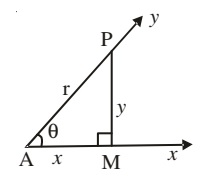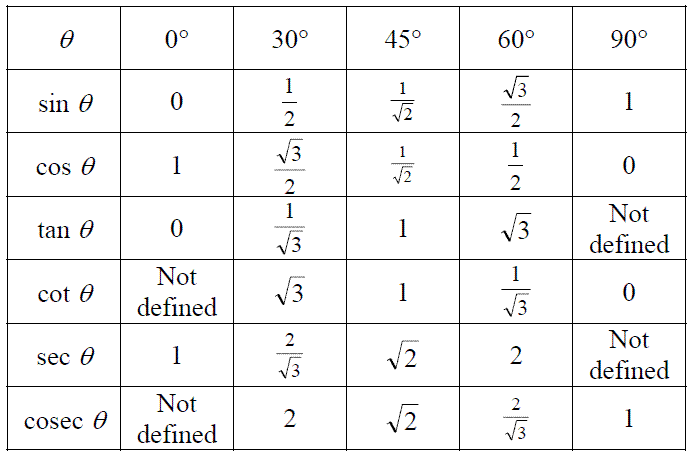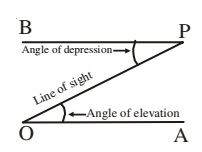Introduction to Trigonometry
Basic MathsTrigonometry is that branch of Mathematics which deals with the measurement of the sides and the angles of a triangle and the problems related to angles.
Triangle being the bounded figure with minimum number of sides serve the purpose of building blocks for study of any figure bounded by straight lines. Right angled triangles get easy link with study of circles as well.
In Trigonometry, the main focus is study of right angled triangle.
Trigonometric Ratios
Ratios of the sides of a triangle with respect to its acute angles are called trigonometric ratios.
In the right angled ∆AMP, For acute angle PAM = θ

Base = AM = x, Perpendicular = PM = y, Hypotenuse = AP = r
Certain ratios involving the sides of a right triangle are called trigonometric ratios.
sin θ = y/r
cos θ = x/r
tan θ = y/x
cosec θ = r/y
sec θ = r/x
cot θ = x/y
$$ \sin A = \frac{\text{opposite}}{\text{hypotenuse}} = \frac{BC}{AC} $$
$$ \cos A = \frac{\text{adjacent}}{\text{hypotenuse}} = \frac{AB}{AC} $$
$$ \tan A = \frac{\text{opposite}}{\text{adjacent}} = \frac{BC}{AB} $$
If two sides of any right triangle are given, then all the six trigonometric ratios can be written. If one trigonometric ratio is given, then other trigonometric ratios can be written by using Pythagoras theorem or trigonometric identities.
sin θ and cosec θ are reciprocals of each other. Similarly cot θ and sec θ are respectively reciprocals of tan θ and cos θ.
When two sides of a right-triangle are given, its third side can be found out by using the Pythagoras theorem. Then, you can find the trigonometric ratios of the given angle.
Example 1: ΔPQR is a right triangle, right angled at Q. If PQ = 5 cm and QR = 12 cm, find the values of sin R, cos R and tan R.
Example 2: ΔPQR is right-angled at Q, PR = 25 cm, PQ = 7 cm and ∠PRQ = θ. Find the value of tan θ, cosec θ and sec θ.
When you know one trigonometric ratio and you have to find the values of other t-ratios, you can use the definition of t-ratios and the Pythagoras theorem.
Example 3: If cos θ = 7/25, find the values of sin θ and tan θ.
Relationship Between T-Ratios
In a right triangle ABC, right angled at B:
$$ \tan \theta = \frac{\sin \theta}{\cos \theta} $$
$$ \cot \theta = \frac{1}{\tan \theta} = \frac{\cos \theta}{\sin \theta} $$
$$ \sec \theta = \frac{1}{\cos \theta} $$
$$ \csc \theta = \frac{1}{\sin \theta} $$
Trigonometric Identities
An equation involving trigonometric ratios of an angle θ is said to be a trigonometric identity if it is satisfied for all values of θ for which the given trigonometric ratios are defined.
$$ \sin^2 \theta + \cos^2 \theta = 1 $$
$$ \sec^2 \theta - \tan^2 \theta = 1 \text{ or } \sec^2 \theta = 1 + \tan^2 \theta $$
$$ \csc^2 \theta - \cot^2 \theta = 1 \text{ or } \csc^2 \theta = 1 + \cot^2 \theta $$
Method to solve questions on Trigonometric identities
- Choose L.H.S. or R.H.S., whichever looks to be easy to simplify.
- Use different identities to simplify the L.H.S. (or R.H.S.) and arrive at the result on the other hand side.
- If you don’t get the result on R.H.S. (or L.H.S.) arrive at an appropriate result and then simplify the other side to get the result already obtained.
- As both sides of the identity have been proved to be equal the identity is established.
T-Ratios of Complementary Angles
Two angles are complementary if their sum is 90º. If the sum of two angles A and B is 90º, then ∠A and ∠B are complementary angles and each of them is complement of the other.
If θ is an acute angle, then (90º - θ) is a complementary angle for θ.
sin (90º - θ) = cos θ and cos (90º - θ) = sin θ
tan (90º - θ)= cot θ and cot (90º - θ) = tan θ
cosec (90º - θ) = sec θ and sec (90º - θ) = cosec θ
Trigonometric Ratios of Special Angles
Values of trigonometric ratios of angles of 0º, 30º, 45º, 60º and 90º. Some trigonometric ratios of 0º and 90º are not defined.

Applications of Trigonometry
Trigonometry can be used to determine the distance between the objects or the heights of objects.
Line of Sight
If an observer is at O and the point P is under consideration then the line OP is called line of sight of the point P.

Angle of Elevation
When the observer is looking at an object (P) which is at a greater height than the observer (O), he has to lift his eyes to see the object and an angle of elevation is formed between the line of sight joining the observer’s eye to the object and the horizontal line.
Angle between the line of sight and the horizontal line OA is known as angle of elevation of point P as seen from O.
Angle of Depression
When the observer at a greater height, is looking at an object at a lesser height, the angle formed between the line of sight and the horizontal line is called an angle of depression.
If an observer is at P and the object under consideration is at O, then the ∠BPO is known as angle of depression of O as seen from P.
Relation between angle of elevation and angle of depression: Angle of elevation of a point P as seen form O is equal to the angle of depression of O as seen from P.
Example 4: A ladder leaning against a window of a house makes an angle of 60º with the ground. If the length of the ladder is 6 m, find the distance of the foot of the ladder from the wall.
Example 5: A tower stands vertically on the ground. The angle of elevation from a point on the ground, which is 30 m away from the foot of the tower is 30º. Find the height of the tower.
Example 6: A balloon is connected to a meteorological ground station by a cable of length 100 m inclined at 60º to the horizontal. Find the height of the balloon from the ground assuming that there is no slack in the cable.
Example 7: The upper part of a tree is broken by the strong wind. The top of the tree makes an angle of 30º with the horizontal ground. The distance between the base of the tree and the point where it touches the ground is 10 m. Find the height of the tree.
Example 8: The shadow of a tower, when the angle of elevation of the sun is 45º is found to be 10 metres longer than when it was 60º. Find the height of the tower.
Example 9: An aeroplane when 3000 m high passes vertically above another aeroplane at an instant when the angles of elevation of the two aeroplanes from the same point on the ground are 60º and 45º respectively. Find the vertical distance between the two planes.
Example 10: The angle of elevation of the top of a building from the foot of a tower is 30º and the angle of elevation of the top of the tower from the foot of the building is 60º. If the tower is 50 m high, find the height of the building.
Example 11: A person standing on the bank of a river observes that the angle of elevation of the top of a tree standing on the opposite bank is 60º. When he moves 40 metres away from the bank, he finds the angle be 30º. Find the height of the tree and the width of the river.
Example 12: Standing on the top of a tower 100 m high, a person observes two cars on the opposite sides of the tower. If their angles of depression are 45º and 60º, find the distance between the two cars.
Example 13: Two pillars of equal heights are on either side of a road, which is 100 m wide. At a point on the road between the pillars, the angles of elevation of the top of the pillars are 60º and 30º respectively. Find the position of the point between the pillars and the height of each pillar.
Example 14: The angle of elevation of an aeroplane from a point on the ground is 45º. After a flight of 15 seconds, the elevation changes to 30º. If the aeroplane is flying at a constant height of 3000 metres, find the speed of the plane.